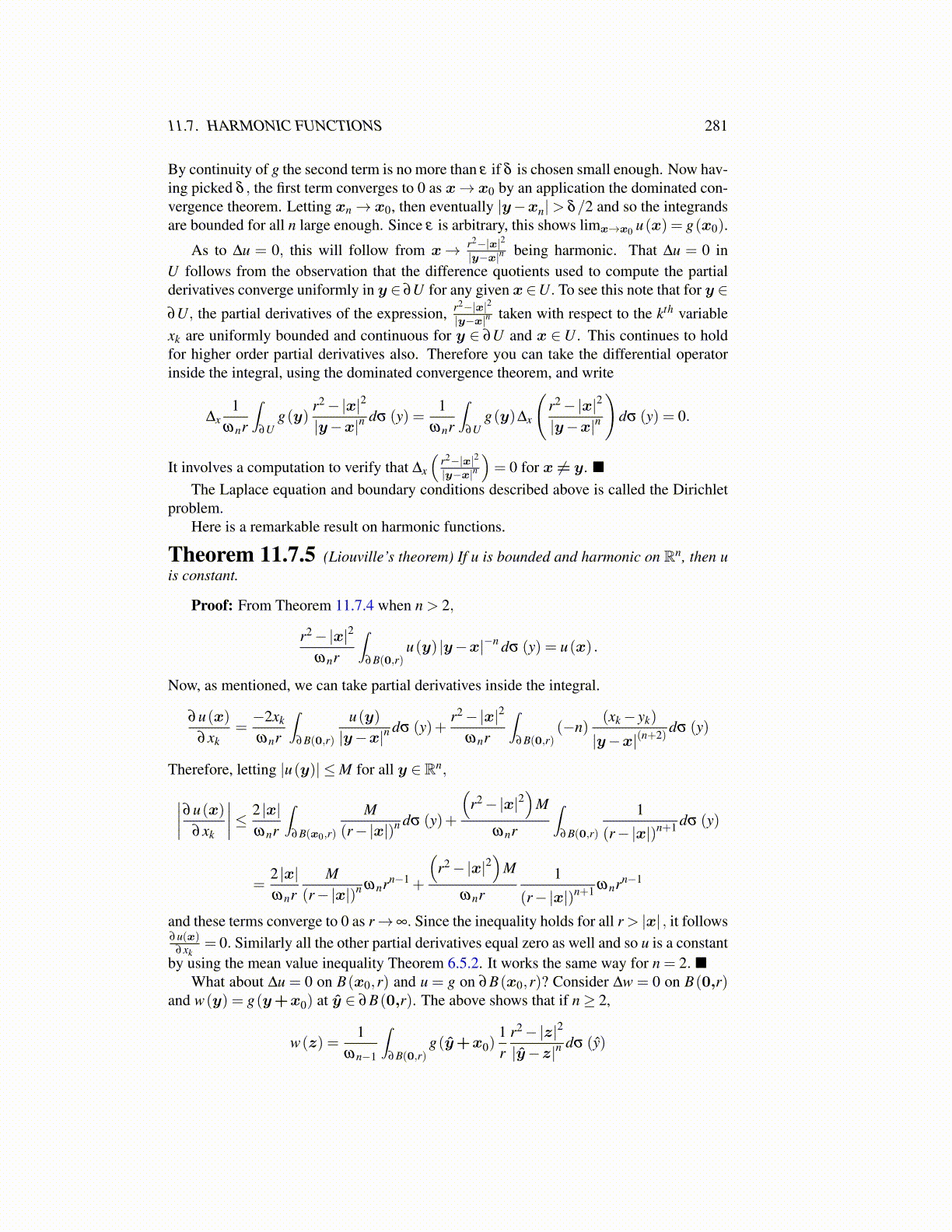
11.7. HARMONIC FUNCTIONS 281
By continuity of g the second term is no more than ε if δ is chosen small enough. Now hav-ing picked δ , the first term converges to 0 as x→ x0 by an application the dominated con-vergence theorem. Letting xn→ x0, then eventually |y−xn|> δ/2 and so the integrandsare bounded for all n large enough. Since ε is arbitrary, this shows limx→x0 u(x) = g(x0).
As to ∆u = 0, this will follow from x→ r2−|x|2|y−x|n being harmonic. That ∆u = 0 in
U follows from the observation that the difference quotients used to compute the partialderivatives converge uniformly in y ∈ ∂U for any given x∈U. To see this note that for y ∈∂U, the partial derivatives of the expression, r2−|x|2
|y−x|n taken with respect to the kth variablexk are uniformly bounded and continuous for y ∈ ∂U and x ∈U . This continues to holdfor higher order partial derivatives also. Therefore you can take the differential operatorinside the integral, using the dominated convergence theorem, and write
∆x1
ωnr
∫∂U
g(y)r2−|x|2
|y−x|ndσ (y) =
1ωnr
∫∂U
g(y)∆x
(r2−|x|2
|y−x|n
)dσ (y) = 0.
It involves a computation to verify that ∆x
(r2−|x|2|y−x|n
)= 0 for x ̸= y. ■
The Laplace equation and boundary conditions described above is called the Dirichletproblem.
Here is a remarkable result on harmonic functions.
Theorem 11.7.5 (Liouville’s theorem) If u is bounded and harmonic on Rn, then uis constant.
Proof: From Theorem 11.7.4 when n > 2,
r2−|x|2
ωnr
∫∂B(0,r)
u(y) |y−x|−n dσ (y) = u(x) .
Now, as mentioned, we can take partial derivatives inside the integral.
∂u(x)∂xk
=−2xk
ωnr
∫∂B(0,r)
u(y)|y−x|n
dσ (y)+r2−|x|2
ωnr
∫∂B(0,r)
(−n)(xk− yk)
|y−x|(n+2) dσ (y)
Therefore, letting |u(y)| ≤M for all y ∈ Rn,∣∣∣∣∂u(x)∂xk
∣∣∣∣≤ 2 |x|ωnr
∫∂B(x0,r)
M(r−|x|)n dσ (y)+
(r2−|x|2
)M
ωnr
∫∂B(0,r)
1
(r−|x|)n+1 dσ (y)
=2 |x|ωnr
M(r−|x|)n ωnrn−1 +
(r2−|x|2
)M
ωnr1
(r−|x|)n+1 ωnrn−1
and these terms converge to 0 as r→∞. Since the inequality holds for all r > |x| , it follows∂u(x)
∂xk= 0. Similarly all the other partial derivatives equal zero as well and so u is a constant
by using the mean value inequality Theorem 6.5.2. It works the same way for n = 2. ■What about ∆u = 0 on B(x0,r) and u = g on ∂B(x0,r)? Consider ∆w = 0 on B(0,r)
and w(y) = g(y+x0) at ŷ ∈ ∂B(0,r). The above shows that if n≥ 2,
w(z) =1
ωn−1
∫∂B(0,r)
g(ŷ+x0)1r
r2−|z|2
|ŷ−z|ndσ (ŷ)